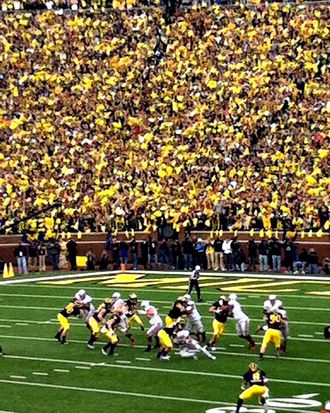
The estimable Brian Cook of mgoblog replied to my piece arguing against putting college athletes on salary. He doesn’t dispute large chunks of my argument, and he proposes two solutions that — unlike taking money from the gymnastics team and turning it into a salary for the football team — make sense.
1. Allow players to sign with agents, and get paid by them. Several restrictions apply. Agents must be registered with both the NCAA and the professional league in question and have clients from a variety of schools. The league in question must project the player as a draftable prospect. And there should be a cap on how much any individual can get paid. The agent system should be phased in gradually and carefully examined for abuse and unintended consequences.
This does a ton of things simultaneously. It lessens the hypocrisy of the system by allowing people who want to pay the kids to do so. It gives the NCAA leverage over a class of people who are banned outright — and are therefore uncontrollable — now. It removes the agents’ incentive to get kids out of school so they can enter a formal contractual relationship. It removes a big chunk of NCAA regulations, allowing the organization to focus on a smaller list of problems. It levels the playing field and removes a whole host of bad PR. It does not impact the schools’ bottom lines.
2. Allow players who enter a draft to retain their eligibility. Hockey players all get drafted at 18 whether they want to or not. They can then play in the NCAA. This has not destroyed college hockey. But if a basketball player puts his name in the draft, he has to withdraw it ever-sooner if he wants to retain his eligibility. Actually going through with the process terminates his college career no matter the outcome.
If a player enters a professional draft and the team who drafts him doesn’t want him on the roster, it doesn’t hurt to let the player in question go back to school and play. Every year, there are players who enter drafts and are passed over entirely; if they’ve retained their academic eligibility, they should be allowed back. Not doing so is punitive.
I strongly agree with the second proposal, and the first is at least worth considering. But here’s the nub of where I disagree with Cook. He writes:
The issue is select administrators getting rich while other, poorer people beat their brains out. In such an environment, trips to Miami and free tattoos and loaner cars are inevitable. Fixing that is the real issue.
I don’t get this. I don’t get any part of it, actually. Start with “beating their brains out.” First, this only applies to football. Is he saying we should pay football players but not basketball players? Second, most of the football players who “beat their brains out” are doing it for programs that lose money. A huge chunk of them are walk-ons who, we can assume, want to play football and don’t view it as a brain-cells-for-cash transaction. The existence of high-school football suggests the same thing. Perhaps we should consider regarding sports as something that athletes love, unfashionably corny as it might be to do so.
Next, “administrators” get rich. You mean like, associate athletic directors? University bureaucrats earning upper-middle-class salaries? What does that have to do with free tattoos and loaner cars? Indeed, how would Cook’s proposed reforms, or any reforms, stop that? People like money. And schools like getting good recruits. It will always be an advantage to pay recruits to come to your school. That would be true even if those recruits have access to other sources of income. (It would actually make it easier to hide illegal payments.) Indeed, illegal payments were probably more widespread decades ago before television money exploded. Nothing about paying players will reduce the incentive for schools to gain competitive recruiting advantage. If that’s the “real issue” you’re trying to solve, you’re barking up the wrong tree.
To me, the issue is protecting the welfare of student athletes. You have a lot of 18- to 22-year-olds playing sports. Almost all of them want to get a college degree. Yet the demands of sports make it hard for them to make full use of their educational opportunities while also fulfilling the official or unofficial time requirements of athletics participation. To me, this argues for reforms aimed at securing real educational opportunity – guaranteeing five years in school for all scholarship athletes and freshman ineligibility. This gives athletes a chance to focus on their classes before they’re competing in varsity sports, a change that I think would help acclimate them to the habits of college academic life. Five years – which ought to include four spring/summer terms – would essentially allow varsity athletes to take a much lower course burden, making the workload manageable.
My main point is that it’s a mistake to view college athletes in vulgar Marxist terms. There’s no meaningful improvements to be made by identifying and cutting out a parasite exploiting the labor of athletes. Following the money simply doesn’t get you anywhere. What you have to follow is the lived experience of the players.
